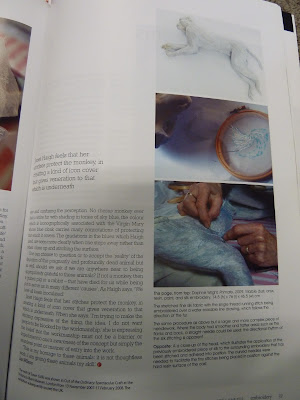A rather spooky form of embroidery can be seen in Janet Haigh’s work. I found an article about work she was commissioned to complete in the Embroidery magazine, issue May/June 2010.
I find this piece shocking at first and slightly disturbing. She has created embroidery around the shape of a dead monkey. The monkey had been bred for research purposes and Haigh took a cast of the body. She used a plasticized material which would allow her to stitch in surface embellishment.
She then started to embroidery the monkey in mainly white silk with shades of blue and green using straight stitching. By embroidering the whole surface of the body Haigh sees this as protecting the monkey and giving it innocence. It’s meant to question our appreciation for these animals and how they have died for us.
I find her work very moving. It definitely has a sadness about it and I almost feel a ‘mothering’ instinct as if I want to protect the monkey. Having it completely in white gives a very peaceful feeling towards its form.










